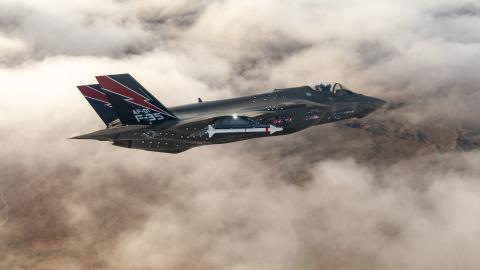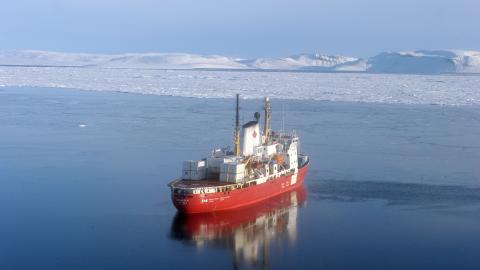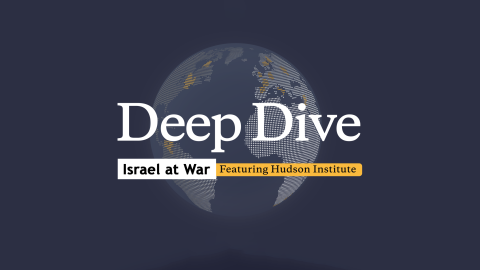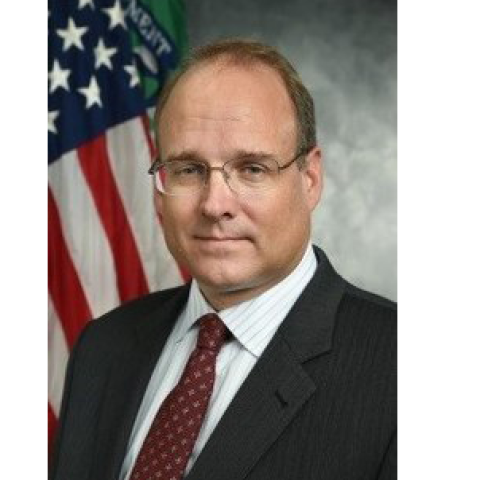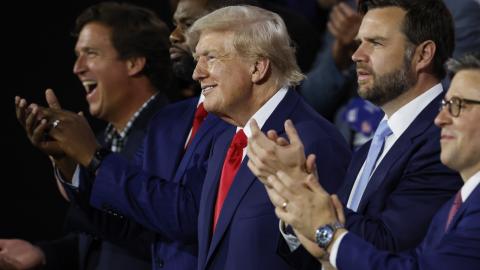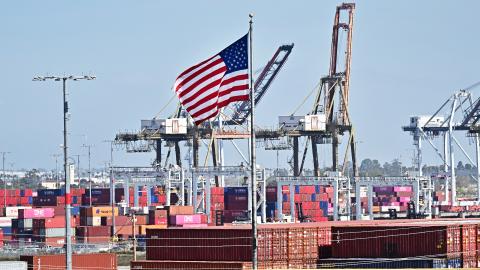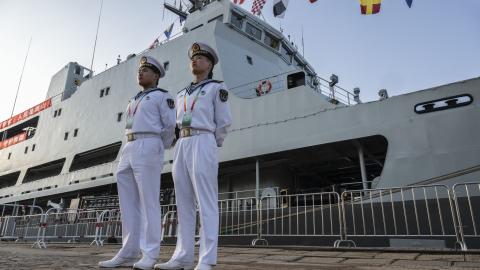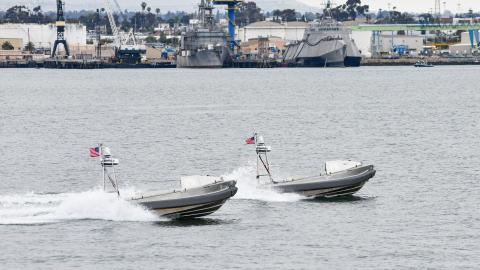
Maritime Security and Next-Generation Technologies: A Platform for Cooperation between NATO and Its Asia-Pacific Partners
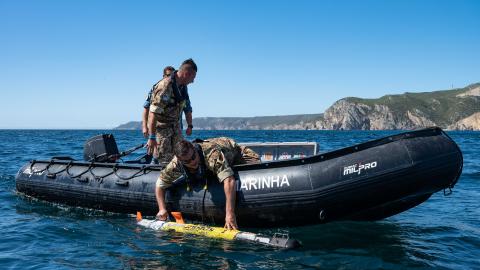

Head of Policy Planning, Office of the Secretary General, NATO
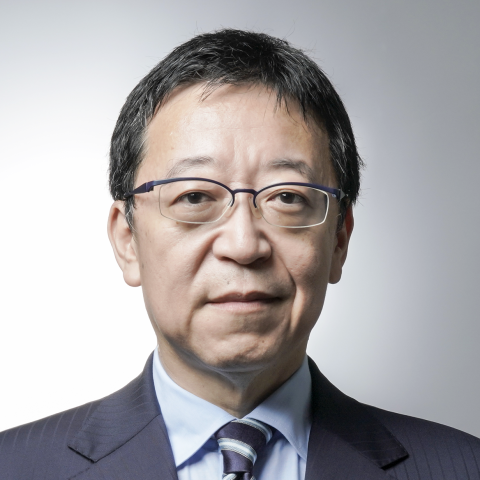
Senior Research Fellow, Sasakawa Peace Foundation

Senior Fellow and Director, Center on Europe and Eurasia
Peter Rough is a senior fellow and director of the Center on Europe and Eurasia at Hudson Institute.
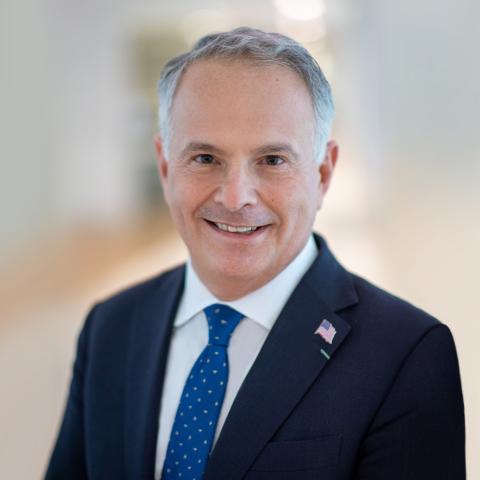
Japan Chair
Kenneth R. Weinstein is the Japan Chair at Hudson Institute.

Senior Fellow (Nonresident)
Liselotte Odgaard is a nonresident senior fellow at Hudson Institute.
Moving the partnership between the North Atlantic Treaty Organization and its Asia-Pacific partners from dialogue to cooperation is becoming increasingly urgent as Russia and China create a two-front challenge for the United States and its allies. But maritime security, hybrid warfare challenges, and increasing automation are ideal points of departure to get cooperation off the ground.
Rapid technological change and global interconnection have changed the maritime threat environment and the capabilities that nations use to address it. Maritime hybrid warfare threats from Russia and China are on the rise. These operations are generally conducted in coastal waters and feature the use of civilian and coast guard vessels manned by non-uniformed personnel armed with off-the-shelf systems.
Are the US and its allies prepared for these threats? Warships are expensive and should be built to last 30 years or more. But the frequent emergence of new threats involving complex actors challenges ships’ lifespans. In the Russia-Ukraine War and in Operation Prosperity Guardian in the Red Sea, allies and partner forces shoot down cheap enemy drones with missiles that cost millions.
Should Washington and its allies build smaller and cheaper ships and create redundancy to reduce vulnerability? Can the defense industry develop laser technology to shoot down enemy drones and replace expensive missiles? Can greater flexibility, rather than specialization, guide the development of warships to prepare them for a variety of complex threats? Is US and allied ship production sufficient to meet the demand for affordable capabilities at a time when national defenses are stretched thin?
Hudson’s Liselotte Odgaard will moderate a panel with
Event Transcript
This transcription is automatically generated and edited lightly for accuracy. Please excuse any errors.
Liselotte Odgaard:
Okay, welcome to this in-person event at Hudson Institute about maritime security and next-generation technologies and if these areas can be a platform for cooperation between NATO and its Asia Pacific partners. The event also launches the project on NATO corporation with its Asian partners that is sponsored by Sasakawa Peace Foundation and which will be hosted by Hudson Institute. I’m Liselotte Odgaard, I’m a senior fellow at Hudson Institute, and I’ll moderate this event. It’ll be a conversation with Benedetta Berti, which is head of policy planning at the Office of the Secretary General at NATO HQ. Online with us we have Tsuneo Watanabe, he’s a senior fellow at the Sasakawa Peace Foundation in Tokyo. We also have Peter Rough at the far side, which is a director at the Center on Europe and Eurasia at Hudson Institute. And we have Kenneth Weinstein, who’s Japan chair at Hudson Institute. Welcome. I’ll start with you Benedetta.
In modern maritime warfare, we talk a lot about redundancy and flexibility, and these have become key issues for various reasons. We use $10 million missiles to shoot down $400 drones. The threats that the US alliance system is facing are changing quickly as demonstrated with the war in Ukraine, the situation in the Red Sea. In a Hudson event in June, NATO chair of the military committee, Admiral Bauer, commented on this saying that political will and our defense industrial base determine if we can successfully engage in future wars. Do we have the political will and the defense industrial base, in your view, to meet the demand for affordable and flexible capabilities that can be used against a variety of threats? If not, what do we need to do to achieve those preconditions?
Benedetta Berti:
Right. Well, thank you Liselotte, and thank you to the Hudson Institute for hosting this I think very timely conversation. Maybe I’ll just say a few words to frame where I think we are in terms of getting the political will and the defense industrial base in line so that we meet what I would call the demands of the most complex, dangerous and volatile security environment we essentially face for generations. Unsurprisingly, I would agree with Admiral Bauer in saying that political will and defense capacity are really strong pillars of how we get there. We are here in town as NATO for the 75th anniversary summit, and I think we are starting by taking stock of all the progress that has been made by NATO allies, now an alliance of 32 countries with Sweden joining as NATO’s 32nd ally this year. I think it’s important to start by taking stock of what we’ve done right because there’s a lot, there’s a lot of progress to report.
In terms of political will, there’s many ways you can measure political will. I am a, let’s say, simple person and I look a lot at spending. Show me where you put your money and I will tell you where your priorities are, and I think here we can report that there’s been indeed a very important upward trajectory. We started in 2014 essentially with only three allies, three NATO allies, spending 2 percent of their GDP on defense spending. Fast-forward to a decade later, we are now two thirds of allies spending 2 percent or more. All allies with clear defense plans in place to meet the 2 percent target. Only this year we had an 18 percent increase in defense spending by European allies and Canada bringing a grand total of 600 plus billion spent on defense by European allies and Canada since 2014. That tells me that that site invented one of our new favorite German words, that understanding of rising to the occasion of the security environment is being taken seriously.
At the Washington summit just in a couple of days you’ll hear that recommitment really to go to 2 percent as the bare minimum. A number of our allies have already said 2 percent is not going to cut it. You have countries like Poland going to 4 percent to meet the defense requirements of the security environment. Political will, we have a good story to tell. We need to continue to keep the foot on the gas so to speak because of course we can’t just rest on our laurels. I think our security environment doesn’t allow for it. Just as important as the work on defense of strengthening and re-energizing our defense industrial base. There’s a lot to be said, but if I had to be very, very brief about this, we, and when I say we, I think about the transatlantic community at large are going from decades of underinvesting in defense underspending and building a defense industrial base that is really about just in time to a completely different restructuring of our defense industrial base where we need capacity, we need spare capacity, we need redundancy.
That’s a massive shift, and NATO is really working on making sure that that shift goes forward swiftly. We do that through many different tools and instruments, and you will see just this week allies committing to a new pledge that really focusing on expanding our defense capacity. To do that, there’s a few things we do successfully we need to continue doing more of. One is to generate that demand signal. If we want our industry to produce more at scale and speed, we need to sign those multi-year contracts and we’re doing that. NATO is an incredibly important demand setter because we set capability targets for all our allies. If you see the capability targets we’re setting now to adapt our deterrence and defense posture, they are the most ambitious one in generations. That’s a clear signal to industry that we are going to need more and we’re going to need more for the long haul.
Part of the work is setting the demand signal. Another important area of work for us is to aggregate demand, so we don’t just spend more, we also spend better. Large scale multinational acquisition projects NATO has played a role all in the last two years. We have over six millions of contracts signed, including from ammunition, Patriot missiles, and again NATO act as an aggregator and we are going to commit to do even more of that. Then there’s work to encourage more transatlantic defense industrial corporation. Again, very important. We need to be innovating, competitive but work more together, and that also means reducing barriers to cooperation. Also work, and I’m also only giving you the headlines because of time constraints. I’m happy to elaborate. But another priority is continue to integrate emerging and disruptive technologies at scale and speed. As we do all this, and this is part of the commitment to reenergize and strengthen our defense industrial capacity, we’re also focusing on how do we protect the defense critical supply chains so that we have the energy, the minerals, the components that our defense industry need?
When you put all this together, I think it’s a very robust signal of the progress going forward. Just this week in Washington, I think very important for this conversation, you will also hear that as part of our strategy we’re also looking at really deepening the defense cooperation with our partners. We’re thinking Ukraine, but we’re also thinking our partners in the Indo-Pacific, Australia, Japan, Korea, and New Zealand. All of this is good. We need to do more of it to ensure that the redundancy exactly as you talk about. There’s also I think more work to be done, and I’ll stop here in terms of flexibility, and that requires I think throughout our national systems and collectively to have an in-depth refraction about procurement. How do we disrupt procurement? How do we make it more nimble? Faster? Responsive? Really focusing on the effects we need to achieve rather than the capabilities in certain areas simply because the technological advancements outpace our processes.
I think that’s an important area of work. I’ll stop here, not just disrupt, we think about procurement, but also we think about defense cooperation with industry. I think that’s really important so that we are really working with industry from the get go, integrated in from the beginning of the conceptual phases of development of requirements. I think if we do all this, we are on the right track. Notice, I haven’t mentioned a lot in terms of what we do with Indo-Pacific partners, but just to close all of this we should be doing with the shared objective of fostering interoperability, common standards, and a joint situational awareness picture. I’ll just stop here for the opening.
Liselotte Odgaard:
Thank you Benedetta. I will turn to one of your Asia Pacific partners or our partner in NATO asking Tsuneo Watanabe, who’s with us online, about the US-Japan efforts first. Because here we see major efforts to strengthen defense cooperation, and it includes a US-Japanese forum on defense industrial cooperation, acquisition and sustainment that held its first meeting just here in June. I wanted to ask you, what is your assessment of the outcome of this DICAS forum, and can NATO build on these efforts to include a wider circle of US allies in Asia in strengthening joint defense production and procurement, for example, in ship building and other areas? Tsuneo? You have to unmute yourself. We can’t hear you.
Okay. Maybe I’ll proceed with someone else, and we’ll return to the scenario. Kenneth Weinstein, Russia is an imminent threat in Europe and China is a main threat, especially in Asia, some would say. Others would say globally. At the same time, it’s clear that Russian-Chinese strategic cooperation has been enhanced, and some efforts on our side has been made to mirror this development. Our Asian allies and partners has adopted sanctions in support of Ukraine during the war with Russia. The EU has strengthened corporation with Taiwan, but we’re still far away from defense commitments across the two theaters. Do you see a division of labor developing where Europe focuses on Russia and Asia focuses on China? If that’s happening, what’s the consequences for the US alliance system or are the two theaters brought together?
Kenneth R. Weinstein:
Firstly, delighted to be here with this distinguished panel. Let me just first start by noting today is the second anniversary of the assassination of Shinzo Abe, who was a great friend of the United States, a great friend of Hudson Institute, a great friend of NATO’s, and a great friend of mine. Any discussion on NATO-Japan cooperation that takes place on the anniversary of his death has to recognize the signature contributions he made, his visit to Brussels to meet with Secretary Stoltenberg, his plan in 2017 that we’re getting very close to set up a Japanese mission to NATO and the like. Just want to begin with his strategic understanding of the linkages between the various strategic theaters. I’d say the following on Russia, China, Europe, Indo-Pacific. One, I think it is absolutely critical that our European allies bear far greater responsibility for meeting the Russia challenge than they have in the past. They are starting to step up.
The addition of Finland and Sweden to NATO, which are countries that are security providers, not security takers. The increases in defense spending and in capabilities that outlined are all critical, but it really does need to go further. It needs to go further for a variety of reasons, not simply the question of political will that matters here in Washington and the perception for far too long and every American president since Eisenhower has talked about the need for our European allies to step up significantly in defense spending and in capabilities, but also at this time when we are becoming increasingly focused on the Indo-Pacific. It’s not just Taiwan, it’s the second Scarborough Shoal, it’s the Philippines, it’s the Senkakus in Japan, and it’s also the deepening role that North Korea is playing as a munitions’ provider to Russia.
We just saw the spectacle of Vladimir Putin going to Pyongyang, a place he hadn’t visited for about a quarter-century, to deepen the alliance between Moscow and Pyongyang. Pyongyang, it poses obviously not just a threat to our allies in South Korea, our IP4 partners in Japan, but also to the United States, but I think it is too simple to say that these are two different theaters that need to be completely separated. The issues are absolutely related, and there are those who in this country and in Japan had hoped to be able to split Russia off from China in a variety of ways. While there are certainly tensions in that relationship, the partnership remains strong and will remain strong for the foreseeable future. I wouldn’t say a division of labor, but there should be areas of primary focus. Areas of primary focus, but that does not mean that these areas are separated.
They’re not separated in part because of the supply chain issues that Benedetta mentioned, which affect all of us. This includes the threat of Chinese EVs creating dependence on Chinese manufacturing capabilities, on Chinese rare earth capabilities and the like. But it goes far beyond simply EVs to telecommunications technology to internet technology and the like, so it’s important that the Europeans deepen their focus on Russia while not forgetting the need to focus on the China threat, which is both the strategic and geo-economic. Simultaneously it’s important for us in the United States really to start to shift our focus to the Indo-Pacific, but recognize the major threat that Russia challenges and the linkages between these two theaters.
Liselotte Odgaard:
Okay. Thanks, Ken. Following up on that, I’ll ask Peter Rough. At the moment, Russia, China and others are keeping us very busy, that’s for sure. We’re busy helping Ukraine fight Russia. We’re busy fighting Houthis in the Red Sea. We’re busy helping the Philippines counter China in hybrid warfare and so on. On balance, what would be your assessment of our situation? Do you see a tendency for two competing world orders to emerge? If that’s the case, how’s the US alliance system doing in this strategic competition? Do we have the upper hand still or are we losing?
Peter Rough:
Well, first of all, I would just echo the other two speakers and say thanks for having me. It’s a real pleasure to be here. This may be my home organization, but I don’t take for granted being invited on stage to say a few remarks. I would follow up Ken’s remarks about Prime Minister Abe. I did not have a relationship with Prime Minister Abe, however I distinctly remember him when Ken was running Hudson Institute opening those headquarters in this very room, and he was a very kind, genteel and I think impressive thinker across the board. As to your question, which is a big question and perhaps it deserves a bit of a big answer, I’d start by saying that as a percentage of global GDP, American power remains more or less where it’s been for decades. There is more or less constancy there, and the US still is something like or comprises something like a quarter of world economic firepower.
However, and this is I think what accounts for some of those changes that you’re describing Liselotte, the remaining percentage of global GDP is increasingly concentrated in some of our opponents or adversaries. Moreover, in addition to that concentration of economic weight elsewhere and those trend lines, if one is to believe them, may actually lead further in that direction. I think there is an impression of political weakness in the West by some of those adversaries that there is an opportunity or a moment to really take on the Americans and knock the Americans off their pedestal, destroying the American alliance system. All of these brush fires which have turned into outright conflagrations in the Eastern Mediterranean or in Eastern Europe, I don’t think are coincidental. They’re not necessarily coordinated, but I do think that the same perceptions of American weakness, which is to say lack of resolve or political will, is informing those judgments even if US economic power remains rather formidable.
That revisionism is now out in the open everywhere from the South China Sea to Eastern Europe to the Middle East. At the same time though, I do think that we have certain inherent strengths that our opponents do not. This takes me back to American competitions in past centuries. Democracies tend to, I think, have an edge in coordinating their grand strategies. Paradoxically one would think that authoritarian systems where there is one leader at the top calling all the shots would have the advantage. But if you think back just to World War II, the Churchill-Roosevelt relationship famously managed to coordinate allied strategy in ways that the access powers did not. I would hope that for all of the messiness of alliance management, for all of the various requirements inherent in that, and we’ll see it on display again this week at the Washington summit, there’s a certain strength to that transparency.
There’s a certain innovative quality to it and there is a way of almost trial and error to policymaking improvement along the way which some of our opponents, when they make mistakes, don’t necessarily have. As to the world order we’re in, I am more and more of the mind that we’re moving towards the Sino-American world, a bipolar world. Which isn’t to say that there aren’t major blocks that are not in North America or in East Asia, but just to take two since we’re here this week in Washington on the eve of the NATO summit, Europe has great economic strength and impressive economic qualities, but traditionally has militarily not been able to project power the way the US has. On the other hand, Russia, which I would put in the Chinese camp, has military weight or an industrial backbone, but it clearly is not, absent support from China in particular, able to wither an American-European economic sanctions campaign.
They’ve required the backstop of China and others. I think we’re in a loose bipolarity in which the other pools in the world aren’t able to truly act as pools because they might be strong in one area but deficient in another. Whereas in the US and China, I see almost fully forged formed superpowers both economically, militarily and politically. A last point since you raised those incidents in the South China Sea in Europe and in the Red Sea, since there is one active war, major war, ongoing in Europe, I put Gaza into a different category. I’m of the mind that Russia has basically three levers to put it simply. One is the unconventional lever at the bottom rung, the next is the conventional, and the highest is the nuclear unconventional level. The conventional I think for the foreseeable future is just tied up in Ukraine.
We see that if you assess the balance of power in Kaliningrad or elsewhere. They’ve just put their kit into that campaign. I suspect that will continue, which leaves two levers to Vladimir Putin. One is the nuclear, and we see the saber-rattling, the open movements and snap exercises, which traditionally would not have been conducted in front of the Klieg lights in front of the cameras for the West to observe in an attempt to push the United States and Europe away so that Vladimir Putin can get in a one-on-one matchup with Ukraine and defeat it. I expect that to continue. Then at the lower rung, the hybrid warfare is clearly an angle available to Putin that he is playing with increasing intensity. The Lithuanian foreign minister will be at Hudson tomorrow at the NATO public forum, at the NATO summit in the days after that.
He is Foreign Minister Landsbergis made a point of highlighting this publicly at the informal ministerial in Prague and the lead up to the preparation for this summit. This was on the top of the agenda for a lot of the foreign ministers from arson attacks to sabotage to removal of buoys, so disputing boundaries, to attacks on critical infrastructure underwater. The Russians are I think testing red lines, even dipping their toes over it, forcing I think the West to come to an agreement on what actually are we facing? Are we already in an active war situation with the Russians or is this of a different category altogether? As long as the conventional is occupied by Ukraine and the tenacity of the Ukrainians is beating up the Russian conventional force, even as it reconstitutes, I expect the unconventional and the nuclear to continue.
Liselotte Odgaard:
Thanks, Peter. Can we turn to Tsuneo Watanabe? Or still silent? It seems to be still silent. Okay. I’ll return to Benedetta. Peter, you mentioned that the standard issue. . . Well, you mentioned the Second World War at least, and here the standard issue was very important. That was one of the reasons that we won the war on our side, and I wanted to ask you about that, Benedetta. This is essential to have the same standards, and this is also why China is spreading its tech standards to the rest of the world along with its economic development and growth build and road initiative. NATO’s Multi-Domain Operations concept requires joint standards to work, for example, to allow for data sharing in as well as outside the military domain and a lot of other issues. What’s the situation in NATO and its relations with partner countries in this respect? Is it feasible to aim for joint standards or how do we work with this issue?
Benedetta Berti:
Thank you. That’s another very important question. I’ll get to it in a second. My bottom line upfront will be why interoperability/interchangeability has become an issue of strategic importance and will be, and that’s why we’ll be featured prominently at the summit as well. But before I go into the standards, with your permission, just one word to agree with my co-panelists and one on the importance of the framing of this conversation because both refer to Prime Minister’s Abe vision about which a few years ago seemed just that, a vision about the security interlinkages between the two theaters. I think that now in 2024, how accurate that assessment is has really percolated and been internalized by all of us. It’s now so obvious, and I think it’s very important that we recognize that as we go into a more quote, unquote, “Technical discussion,” that the security and strategic interlinkages between your Atlantic and Indo-Pacific theaters are really a core trend in which it is very possible to say that crisis and conflict in each of this theater would affect the other and vice versa.
That’s why sitting at NATO in Brussels, it’s possible for me to say that we have a vested interest in peace and stability in a free and open Indo-Pacific in as much as any security crisis in that theater would have a direct impact on European and your Atlantic security. I would also recognize that our Indo-Pacific partners, Australia, Japan, the Republic of Korea, and New Zealand, have made that very same calculation. That’s why they are attending the NATO summit for the third year in a row, and that’s why they’re so deliberately steadfast in their support for Ukraine because we also understand that what’s at stake there. It’s beyond just Ukraine’s right to exist as a sovereign independent state. It’s beyond what type of security and stability we want in Europe. It’s really about what type of signal we sent broadly worldwide to assertive authoritarian actors and what would be the cost of a victory by the Russian Federation for let’s say deterrent in the Indo-Pacific. What type of signal would that send to Beijing?
I think that connection is so evident today also because as both speakers have said. . . I’m not saying anything new, I just want to really emphasize this, also because this growing strategic alignment and concerted action by assertive authoritarian actors. I just want to take a second to recognize that because even a year ago we would not have expected that the PRC is today the key enabler of Russia’s war of aggression against Ukraine through this provision of dual-use goods. The key enabler that the DPR case is providing ammunitions in a way that is really having a battlefield impact. The same for Iranian drones just to mention some equipments. That’s the strongest case I can think for the interlinkages between the two theaters, but also for the importance of maintaining that transatlantic bond and growing cooperation with the Indo-Pacific. Because if you ask about strength when we come together, NATO allies plus our Indo-Pacific partners, we’re talking about 60 percent of the world’s GDP and military might.
That is incredibly important I think. With that, the strategic standards. Standards is how we make this happen, right? It’s been one of the really less politically interesting topics for NATO, but it’s been the bread and butter of NATO design material and operational standards so that all allies can work together shoulder to shoulder in an interoperable way. The fact that we’re asked about this is a signal of how serious the security environment is because otherwise that was really confined to the realms of technical. But the issue is that today we have a fairly strong standard setting capacity, but in this security environment and given the reset of our deterrence and defense posture, we need to catch up, which means we need to invest more on standardization, especially when it comes to new equipment and adoption and integration of emerging and disruptive technologies.
That’s an area where we are committing at this summit to really scale the amount of work that we do. Also, individual allies are committing and are doing more to actually swiftly integrate and adopt these standards because we have a lot of them, but they cannot just be good on paper. There’s many areas where they’re good on paper and in realities, but there’s also areas where we need to improve the adoption so that we’re really interoperable and in some systems interchangeable. I think the war in Ukraine teaches that what is the cost of having not interchangeable or interoperable systems? That’s going to be a very important area of focus for the Washington summit. It’s not just between NATO allies, this also opens a very important area of cooperation with partners. Ukraine, of course, but also Indo-Pacific partners who are already part of our interoperability platform.
But we can do more, especially when it comes to science and technology, emerging and disruptive technologies under integration. This also opens I think a very promising path towards increased defense cooperation. I think that would be very important. When I look into the future and I think of really what does it take to have an integrated deterrence and defense approach across two theaters? I think building interoperability and defense cooperation with our Indo-Pacific partners is going to play a very important role in that. I’ll stop here just because I spoke too much, but happy to elaborate on some other priorities later.
Liselotte Odgaard:
Thanks, Benedetta. I’ll turn to Ken again because we’ve talked sometimes about the 2 percent target. As Benedetta has already mentioned, NATO member states are extremely focused on the 2 percent of GDP target as a minimum requirement regarding defense spending. NATO’s capabilities targets have also become a main focus area, as you also mentioned, because member states cannot afford very easily to invest in capabilities that are not included in those targets. But on the other hand, sometimes the target seems not to include capabilities that you would think NATO values. That could be lightly manned ships in the Baltic Sea that could act as force multiplies for frigates. It could be ice-strengthened frigates with anti-air and anti-submarine capabilities that would help deter Russia, et cetera. Does NATO need to optimize these processes that determine the capability targets, and if so, how can we do this? Benedetta, if you want to comment as well? I don’t know.
Kenneth R. Weinstein:
Yeah. Benedetta knows far more than I do about this. Look, I think what we’ve seen in Ukraine, Ukraine has become a laboratory of warfare. What we have seen the Ukrainian people do with very modest defense capabilities until recently is to develop in an extraordinary manner their asymmetric capabilities, whether that be drone warfare, whether that be the use of software-based programs to enhance targeting, to use publicly available data to move significantly to target Russian operations, Russian officials. We saw in the early stages of the war just how effective that was at stopping both the Russian supply chain and doing massive damage to the Russian military. We have seen since, however, the Russians start now to focus on these capacities as well, and it has helped them to slow down various Ukrainian offenses.
I would say that as we develop these capabilities, it is incredibly critical that we do so in a manner that recognizes the changing dynamic of warfare, that we not get fixed into doing things because we have always done them. That includes some NATO countries that include in their 2 percent a significant amount for pensions and the like, rather than on these cutting edge capabilities. Just to link NATO and the Indo-Pacific, I think we’re seeing similar developments in Japan, which is reaching the 2 percent of GDP gold by 2027, the NATO standard under the leadership of Prime Minister Kishida, and there have been both three significant Japanese strategic documents released including the defense buildup plan. Much of it is focused on these areas of new technologies, new capabilities, the need for Japan to develop underwater unmanned vehicles, UAVs, USVs, which are critical both in combining them with these other capabilities in terms of both long-range targeting, but the need to do interdiction in the South China Sea around the Senkakus and the like.
These kinds of capabilities, the ability to swarm drones, will make up for Japan’s quantitative deficiencies when it comes to meeting the challenge of the People’s Liberation Army, and will also be critical for Japan’s Indo-Pacific partners and our allies, both the IP4 partners, but also countries like the Philippines, which are increasingly being included in Japan’s defense ecosphere to face the challenge at second Scarborough Shoal, but also the Pacific Island nations that are finding themselves under increasing encroachment and don’t have the ability to build the big kinds of systems that were the mainstay of our alliance and the NATO alliance for some time. A shift to these more flexible, more forward-looking platforms while meeting the other demands really does make sense economically, strategically and also technologically because it keeps countries at the cutting edge of where defense is headed.
Liselotte Odgaard:
Okay. Thanks, Ken. Peter, I want to return to you because I have a question about Europe that you are the expert on. When comparing Europe to the US, China and South Korea-
Tsuneo Watanabe:
Can you hear me? Can you hear me?
Kenneth R. Weinstein:
All right.
Benedetta Berti:
Hello.
Peter Rough:
Skip over me.
Kenneth R. Weinstein:
We’re going to increase coordination-
Liselotte Odgaard:
He’s on now.
Kenneth R. Weinstein:
. . . between the Indo-Pacific and the North Atlantic.
Liselotte Odgaard:
Tsuneo, I’ll return to the question I had for you which was about-
Tsuneo Watanabe:
Okay. Liselotte can you hear me again?
Liselotte Odgaard:
We can hear you. Yeah.
Tsuneo Watanabe:
Okay, good, good. Right.
Liselotte Odgaard:
I asked you earlier on, which is a good follow up to what Ken said, about your assessment of the outcome of the DICAS forum, the US-Japan Defense Industrial Corporation forum, and if NATO can build on these efforts to include a wider circle of US allies in Asia to strengthen joint defense production and procurement? Over to you.
Tsuneo Watanabe:
All right, thank you very much Liselotte. I’m Nabe Watanabe, I’m a senior fellow at the Sasakawa Peace Foundation. I appreciated the invitation and I apologize that I’m a voice traveler over my computer. First of all I really appreciated the Ken’s warm words to the Prime Minister Abe. In Japan, the TV talked about it because it was a day of former Prime Minister Abe was unfortunately assassinated. As a friend of former Prime Minister Abe, I really missed him and still appreciate your warm words. Let me go to the question. I think Prime Minister Abe, the achievement for the really the try to go to the right track of Japan’s defense policy is really now ongoing and current Prime Minister Kishida, who was a foreign minister of Abe cabinet and also to cover Abe’s mission, keep doing many the defense policy. Now, he’s one very first. . . Second prime minister who really tried to cope with United States and the NATO allied partners and very recently, as you mentioned, DICA, the US-Japan Defense Industrial Corporation acquisition and sustainment, D-I-C-A-S, DICAS.
That forum was in Tokyo, actually the head of the very first one with Under Secretary of Defense William Plante, and the counterpart Mr. Sasakawa, he’s acquisition technology and the logistic agency commissioner of Ministry of Defense and achievement a lot. But somehow the Japan is now the focusing on the Japan’s own defense industrial base. I tell a little bit the very peculiar and the unique history of Japan because in the past, especially the before Prime Minister Abe, Japan has been a very restrained approach for the exploring a defense equipment. It’s a very uniquely the restraint because the reflection of the Japan causing a trouble to the neighbor in the World War II. Not only trouble to neighbor but a trouble to US too. But now it was Prime Minister Abe who really try to recover the old psychological constraint and military constraint and more positive law for the Japan’s contribution to the regional piece. Abe’s strategy free and open in the past week and now Japan is attaching to our own defense the industrial capability.
I think that’s ongoing. Just started. But again, happy to announce US and Japan both counterpart started very good inauguration, and including now Japan is more taking part in, for example, repairing US military vessels around Japan. I think Japan is a host of Seventh Fleet, and the US military vessels in Japan is now taking care of repairing ships. Also, Japan is now doing the co-production of F-35, and that part is also very important part of US defense industry and also maintaining presence in the Pacific. As you may realize, Japan host a major US military base very near to the potential adversary. No mention to say but the North Korea and China. I think let me finish the first my . . . talk and apologize for some inconvenience for my voice.
Liselotte Odgaard:
Okay, thank you. Did you want to comment on how NATO can build on these efforts or include them, Tsuneo?
Tsuneo Watanabe:
Oh, yes. I think the next NATO summit, the Prime Minister Kishida continuously joining the NATO summit. The last summit, I think you remember the G7 gave a security guarantee the Ukraine. It was Fumio Kishida of Japanese prime minister was I think the summit chair country over for G7. He and President Biden both gave I think the individual countries’ agreement with the somehow security guarantee the Ukraine. Now, Japan is cooperating more NATO for the Ukraine too I think. Japan really expect NATO to cooperate with Japan in the Pacific, the security area. I think that for Japan, NATO is critically important. For US-Japan, I think NATO, especially the European the allied partner is critical, including the joint cooperation for the industrial base and also some trying to prepare for the emergency in the Indo-Pacific area and the Japan and as a partner like South Korea and Australia, New Zealand need to help to the situation in Europe too.
Liselotte Odgaard:
Okay, thank you. Now we’ll return to Peter Rough because when comparing Europe to the US and to China, South Korea, others in the area of next generation technologies and its application in defense, Europe seems to be lacking behind. Europe does have an innovative industrial base in high-tech, but it also has national protective measures. It has insufficient private long-term investments in the area and other issues perhaps that are among the reasons that Europe as a whole is not at the forefront of tech competition, some would argue. Where does that leave Europe when discussing enhanced defense cooperation across the North American, European and Asian theaters?
Peter Rough:
I would just make two points. The first is that I think the European and American defense industrial base requires both scale and adaptability. This is not an original thought of mine. Bryan Clark who runs our Center for Defense Concepts and Technology is really the proselytizer of that message, but it strikes me as eminently reasonable and totally accurate. Because if you build out a munitions stockpile and then your adversary develops a countermeasure like GPS jamming, your entire dib may be obsolete until you’re able to adapt and build a countermeasure to that countermeasure. In the case of drone warfare in Ukraine, how often did we fete and celebrate the Bayraktar for example in the early days of the war in Ukraine. There’s a great smash hit online that you can listen to about the Bayraktar because they were so important at the outset.
One hears much less about them today because the Russians developed countermeasures to that particular system with all due respect to the Bayraktar and the enormous service that they have offered to the Ukrainians. But I think that’s a great example of adaptability and scale at the same time. The other point I’d make since you raised the issue of protectionism or perhaps European governments preferring to support indigenous providers, there is in the US famously the system of defense procurement based on the primes, who I think have a robust structure for shaping requirements when it comes to next-generation ships, when it comes to aircraft or weapons towards the technical programmatic strengths that those primes have. But there’s also, I think there are privately funded firms outside of the primes who tend to focus on new ways of addressing operational challenges and they are trying to I think work through a model that anticipates a military problem and offers almost a finished product to tackle it.
Here too, we could look at for example, high-powered microwaves and drone on drone attack systems of late in the drone combat field that is Ukraine. A lot of them have been hesitant I think to push into the European market because there European governments preferred to fund, even if they’re inferior, their own national champions. Perhaps a way to get around that would be to focus on areas where there aren’t European competitors like I just mentioned, and where US companies have pretty novel and mature solutions for European needs. That could be I think an opening beyond the traditional F-35 prime programs where we already know where there’s pretty regular and serious transatlantic exchange opportunities for smaller VC-funded defense firms to break into the European market. To my thinking, adaptability and scale matter. Then perhaps as a practical matter on the alternative to the prime defense industry in the US that’s been hesitant to go into Europe, look for niche areas where European governments don’t really have alternatives to the Americans right now as a way to build out the transatlantic defense trade and economy.
Liselotte Odgaard:
Okay. Thanks, Peter. Tsuneo Watanabe, I want to ask you a question as well about technology. It’s about artificial intelligence because that also appears to be key to winning future wars, including using AI and scalable ship production facilities for the effective use of drones in war fighting, for intelligence, reconnaissance, surveillance, et cetera. Have our armed forces in North America, Europe and Asia been good enough at integrating artificial intelligence, and is this an area where there’s room for applying lessons learned between NATO and its Asian allies?
Tsuneo Watanabe:
Oh, yes. I think first of all, the Japanese prime minister and the US President Biden already agree in the bilateral summits for the technology cooperation and also the special program for the AI, the development and the cooperation. That’s a little bit related to somehow the export control over critical technology related to the AI, and I think a high-spec semiconductor too. Somehow the AI is a really game changer for the future warfare. That clearly everybody knows including China and the North Korea. That’s one of the reasons now the US and the US allies are trying to the very cautious export control of high-spec semiconductors and related technology, which could be the parts of AI. Also, how to apply AI for the future combat and the future equipment is critical. That’s one of the reasons I think . . . in the past two or three years it was a Japan and India, which US leader agree to share the more closer cooperation for the developing technology and also developing a technician which can carry the critical technology too.
I think that’s probably the contrasting to the US is limiting the transfer of technology and research related to the high-tech to China. I think that’s the current. . . The movement. Also, I’d like to point out the GDP2 point, the task. I think already the many NATO members achieved the spending the defense expenditure over 2 percent and Prime Minister Kishida of Japan already promised to the lead to the Japan’s defense expenditure to the 2 percent of GDP in a year 2027. I think in order to reach such kind of the defense, the budget, Japan also really need to maintain rigorous defense capability and the making the good economy. I think that is a key for Japan to have a sustained development for the economy. I think that’s one of the reasons now why the technology is a key because the technology is a seed for the new economic development for the future and Japan is expecting a lot too.
Liselotte Odgaard:
Thank you. We have about eight minutes left and I wanted to check if there were any questions from the audience to any of our speakers? Yes, sir?
Michael Dechada:
Michael Dechada, Booz Allen Hamilton. For the US DOD, risk of unwanted technology transfer is a serious concern when it comes to partnering with defense technologies. What are NATO members and Indo-Pacific partners doing to shore up their cybersecurity policies, practices and general counterintelligence threat perceptions?
Liselotte Odgaard:
Thank you. Ken?
Kenneth R. Weinstein:
Sure. Let me jump in and let me handle the IP foresight of the equation. First of all, three of the IP. . . First Australia, New Zealand being part of the five Is they have already, they have the highest standards in these areas but there has certainly been penetration in Australia in particular and New Zealand as well that the authorities are well aware of and that on the counterintelligence side they’re doing all that they can in cooperation with us to get to a better phase. With regard to Japan, Japan is increasingly aware of deficiencies with regard to cyber hygiene and especially with regard to the need to diminish Chinese penetration of both Japanese government and private facilities. The government has been actively working on this in cooperation with the United States in cooperation with the National Security Agency at the absolute highest levels.
Japan has also put in place a new clearance system for individuals working in the private sector on defense questions. Japan is putting in place facility clearances as well as part of its defense transformation and is also actively discussing putting in place active cyber measures for the first time, all of which would help mitigate a challenging situation but is absolutely necessary as Japan moves forward, particularly with the development of the joint combat aircraft program with our NATO allies in Italy and the UK. As for Korea, I think there’s a deepening awareness of the cyber challenge. Also, I can’t speak to specific initiatives that are going on, but I know that President Yoon will I have the honor of interviewing at the NATO public forum in a couple of days. His government is making every effort to enhance cybersecurity and the like, quite concerned about the China challenge and also the North Korea cyber challenge, which they are okay is as serious as the China challenge is.
Liselotte Odgaard:
Thanks, Ken. That was another question over here. Mic is coming.
Walt Hose:
Thank you. Walt Hose, Department of Defense. To what extent has NATO at this point in time thought of or has engaged in aspects of economic statecraft and or economic competition to counter what some of our opposing forces are doing? Thank you.
Liselotte Odgaard:
Benedetta?
Benedetta Berti:
I’ll be very brief, and the answer is through the prism of bolstering allied and collective and national resilience. I think there’s quite a bit of work that is being done, the defacto addresses, the issues you mentioned, which is economic coercion, leveraging of our strategic dependencies and economic vulnerabilities to undermine our securities. In that context I can can just list some of the areas that allies have taken forward through that resilience and preparedness prism there is increasing-
Walt Hose:
I realize some of it gets very sensitive quickly, but when you talk about trying to counter the Belt and Road Initiative, which is already widely proliferated with over a trillion dollars invested by China, we are way behind the power curve. Just again, is NATO even thinking about these things?
Benedetta Berti:
Yes. We are through our work on supply chain security, on protection of critical infrastructure with a specific focus on energy transport, digital and space, which is also something we carry out together with the European Union, which has also regulatory competencies that are especially important when it comes to setting the standards at least for our EU member states. But in general, yes, absolutely. This is about. . . Also, when we talk about strengthening our defense industrial base, part and parcel of that is how do we ensure the security and resilience of our defense critical supply chains?
Of course that also goes into very much looking at issues like critical minerals, dependency in the energy sector. There is substantial work being done, not just on having a common perceptions, common situational awareness and sharing intelligence, but also sharing best practices, consultations, and really shoring up our critical infrastructure because we know that that is going to be a key enabler of our ability to deter and defend credibly. There is a lot of work being done on this, and I think if I have to look into the future, this is certainly an area where we need to continue to develop the work we do.
Liselotte Odgaard:
Thanks, Benedetta. One quick question at the end. You?
Dan Michaels:
Thank you. Dan Michaels with The Wall Street Journal. I wonder if the panel could talk about lessons from Ukraine, maybe for the Pacific in terms of contested logistics? There’s a lot of conversations about security on the tooth side of things, less so on the tail. But the Ukrainians showed at the outside of the war how much damage you can do by hitting supply lines, and the Pacific is a lot bigger than the road to Kiev. Thank you.
Liselotte Odgaard:
Who would like to address. Peter?
Peter Rough:
I’ll just make a general remark and that is I think the lessons of America’s wars in recent decades that if you allow your opponent to sunbathe on the other side of the border and essentially have free-range to organize logistics before moving into the combat zone, it’s a recipe for disaster. Think back to our experiences in Iraq where from Iran and Syria there were rat lines moving in taking on American troops in Iraq. I don’t know how many American troops were maimed, wounded or killed from EMPs that traveled across the Iranian border or Al-Qaeda that came across from Syria. In Afghanistan we had the same problem with safe haven. In Pakistan, in Vietnam, we had problems in Southeast Asia with safe haven and those surrounding states.
So long as the Russians could cool their heels on the Russian side of the Ukraine-Russia border full well in the knowledge that any western systems being provided to Ukraine would not be able to hit them, I think they had an unfair advantage on top of what is already a fight in which there is a far larger, economically more powerful, manpower intensive and industrial based stronger actor invading a smaller one. This is a cliche quote, but of course it’s true, that amateurs talk strategy, professionals talk logistics. I think that Ukraine is systematically preparing the battlefield for what it hopes is a renewed defense defensive at some point, perhaps in 2025. You see that in the way that it’s striking parts of Crimea, the way it has hit into at least parts of the Belgorod sector at Oblast in Russia, which has real effect because the Russians have had to redirect, for example, air defenses from the south to the north.
All of these parts are of course interconnected. Not to mention the real logistical deep supply, which is Russia’s petro economy. The attacks on the refineries have had an impact on Vladimir Putin, and we will never get to negotiations along as the Russians think that they’re better off continuing the fight rather than worse off. Inverting that thought process in the Kremlin is usually important, and that is directly connected to logistics and supply. One final point on logistics and supply, connecting it to Asia, I think a lot of the calculations about Russia’s reconstitution were based on Russia’s industrial capability. How quickly could it refurbish a lot of its military kit and tanks. Once those museum pieces are already on the battlefield, they’re no longer available for refurbishment, then perhaps things move into Ukraine’s favor and away from Russia.
However, those analyses didn’t take into account the enormous potential of the Chinese economy. I think therefore it’s incumbent on Europe and the US to step up and not only assist Ukraine at higher levels to match what the Chinese are doing for Russia, but also in particular for the Europeans in their conversations with the Chinese to say to them, not as I think many of them are doing now, “Knock this off. Now let’s go to other areas in our bilateral relationship.” But put it at the center of the relationship and say, “You are sowing the ground for the next major war in Europe. This will impact all aspects of Beijing’s relationship with European capitals,” and thereby I think try to push back China on dual-use items where, from microelectronics to machine tools, they have been the essential supporter of Russia. Sanction circumvention is an issue, no doubt about that. We can do better, but the real meat of the matter I think is Chinese support for Russia.
Kenneth R. Weinstein:
I could add one point. Anything that we have seen in Europe will dwarf what we will see in the Indo-Pacific with regard to China having dozens of Ho Chi Minh trails both among our adversaries but also among the nations that tilt between us because of the ability to leverage certain elements of the elites against us. It’s also complicated by Japan’s defense policies which don’t allow for the kinds of strikes that might be necessary until Japan itself is actually attacked, and so it is going to be a headache of unbelievable proportions for us.
Liselotte Odgaard:
Tsuneo, do you have one last one-minute comment?
Tsuneo Watanabe:
Sure. I think the lesson from Ukraine, clearly that’s why Japan and the US agree to the DICAS. I think the Japan defense industry renewal is really critical for the continuation of the possible military operation near China or North Korea. I think we really need to keep fighting tyranny of distance, and that’s clearly the industry based in India, Japan. I think a Indo-Pacific partner is critical for the US and the US allied to continuing military operations. I think that Japan is a very positive, I think India is a very positive too. We really need to keep working on and really appreciated the cooperation of a European allied of NATO.
Liselotte Odgaard:
Okay. Thank you. We’re already out of time. Appreciate your attendance. Thank you for joining us here today. We hope to see you soon again at an event at Hudson Institute.
Benedetta Berti:
Thank you.

With Research Fellow Zineb Riboua, Ambassador Zimeray will examine the legal, political, and strategic implications of Sansal’s detention and what it reveals about freedom of expression under authoritarian regimes.


A panel of experts will discuss how the Japanese government should approach domestic political questions, its partnership with America, and Japan’s role in the world.

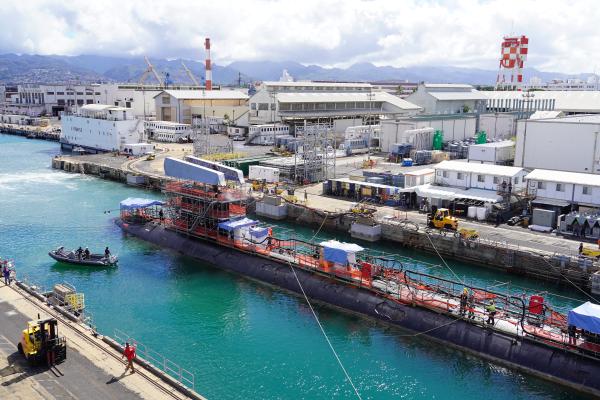
Hudson will welcome Senators Mark Kelly (D-AZ) and Todd Young (R-IN) to discuss their proposal to restore America’s shipping and shipbuilding industries to help deter Chinese aggression.
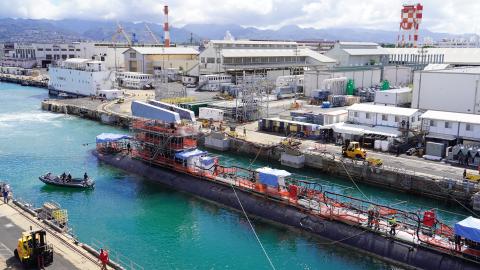
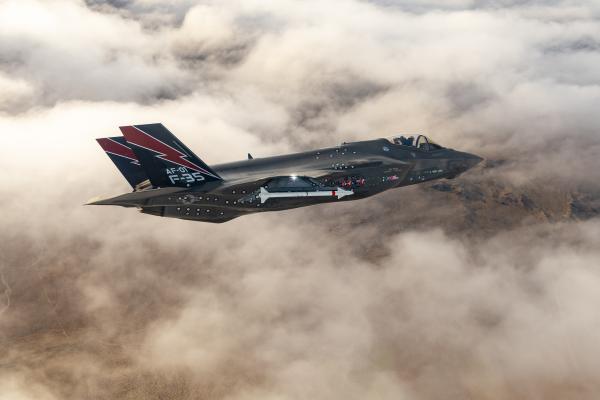
Major General Mark Mitchum will discuss the Air Force’s nascent Integrated Capabilities Command.
